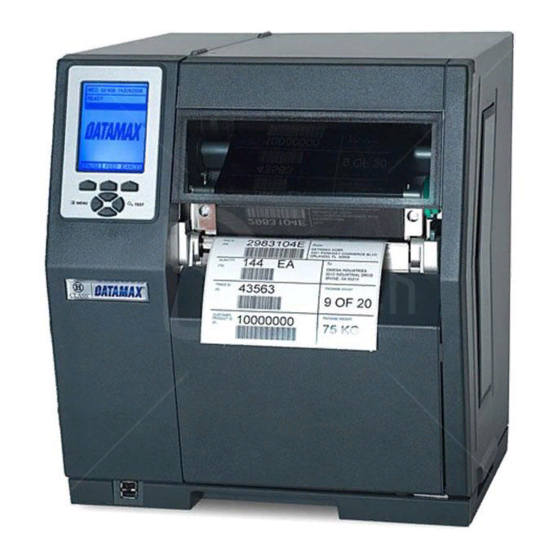
Datamax H-Class Manual
Gpio option
Hide thumbs
Also See for H-Class:
- Manual (26 pages) ,
- Quick start manual (12 pages) ,
- Programmer's manual (330 pages)
Advertisement
Quick Links
Advertisement

Summary of Contents for Datamax H-Class
- Page 1 92-2427-01 Rev.C GPIO Option...
-
Page 3: Tools Required
Overview This document describes the installation and use of the General Purpose Input Output (GPIO) option for the H-Class printer. After verifying the kit contents and tools needed, follow the steps to install and begin using the option. For safety and to avoid equipment damage, turn OFF the power switch and unplug the AC power cord from the printer before starting this installation. - Page 4 COM C RS-232 Cables Part # 32-2300-01 Part # 32-2301-01 COM D RS-232 Cable Host DB-9S Printer RJ45P +5 VDC +5 VDC GROUND GROUND Part # 32-2603-00...
-
Page 5: Step 1: Configuring The Hardware
Step 1: Configuring the Hardware Configure the card to meet your interfacing requirements by arranging hardware jumpers, as described in the following procedure: Always wear a wrist strap and follow standard ESD prevention measures when handling the card. CAUTION A) Remove the card from the packaging and then place the card onto a static-free work area. - Page 6 For direct inputs – GPI/O A - J1 Start of Print Use the printer’s +5VDC and Ground to supply Slew Label the devices interfacing to the GPI/O A inputs Toggle/Pause (as shown in the sample circuit, right). Reprint Ground For isolated inputs – +5 VDC External Source GPI/O A - J1 To provide galvanic isolation for the GPI/O A...
- Page 7 Failure to properly configure the GPIO Port can result in damage to the printer and / or connected devices. WARNING GPI/O Port A Jumper Overview Signal Direction Jumper Position Function / Description Name Installed Printer chassis is used. Ground JMP 8 Removed Ground must be supplied.
- Page 8 GPI/O B (J2) ► Six unassigned inputs are designed to interface to open-collector outputs. These inputs require no external pull-ups, while blocking diodes allow the use of totem pole outputs from +4.5 VDC to + 26 VDC. Optical isolators provide galvanic isolation. Two print control interface circuit examples are given below.
- Page 9 Failure to properly configure the GPIO Port can result in damage to the printer and / or connected devices. WARNING GPI/O Port B Overview Signal Name / Direction Jumper Position Function / Description Printer +5VDC is used (.5 amp maximum). Installed Note: Drawing more than .5 amps can cause unreliable printer operation.
- Page 10 COM C (J4) ► Recognized by the printer as Serial Port C, COM C functions as an auxiliary RS-232 interface or dedicated device port for the RFID and Linear Scanner options. Pin assignments for the port are as follows: Pin Number COM C (J4) +5V (@ .5 amps) Ground...
-
Page 11: Step 2: Installing The Option
Step 2: Installing the Option Install the GPIO Card as described below: A) Turn OFF the Power Switch and unplug the power cord from the AC Power Switch Receptacle. AC Receptacle Screws Card Cage B) Remove the two Screws that secure the Back Panel to the Card Cage, and then remove the Back Panel. - Page 12 Card Cage Cover Plate D) Place the Cover Plate (Item 2) onto Screws the Card Cage, as shown, then install and tighten the two Screws (Item 3) to secure the plate. Step 3: Interfacing Interface the card according to your application requirements (see the drawing below for connector pin-outs, refer to Step 1 for signal details) as follows: A) For GPIO functions connect a GPI/O interface cable to the GPI/O A (J1) and / or GPI/O B (J2) ports.
- Page 13 Step 4: Configuring the Software Settings Configure the printer’s m for the option’s operation. enu settings A) Using the Control Panel, enter the ADVANCED MENU (see the Operator’s Manual for menu navigation details): If using the GPIO A (J1) port, configure the settings to meet the requirements of •...
- Page 14 Input Monitor – Display incoming GPIO binary signal states using the ADVANCED MENU DIAGNOSTICS OPTIONS TESTING TEST GPIO MONITOR GPIO INPUT selection. GPIO A Signals FEED PAUSE REPRT GPIO B Signals Note: Unused, non-connected inputs will have an indeterminate state, and may ...
















Need help?
Do you have a question about the H-Class and is the answer not in the manual?
Questions and answers